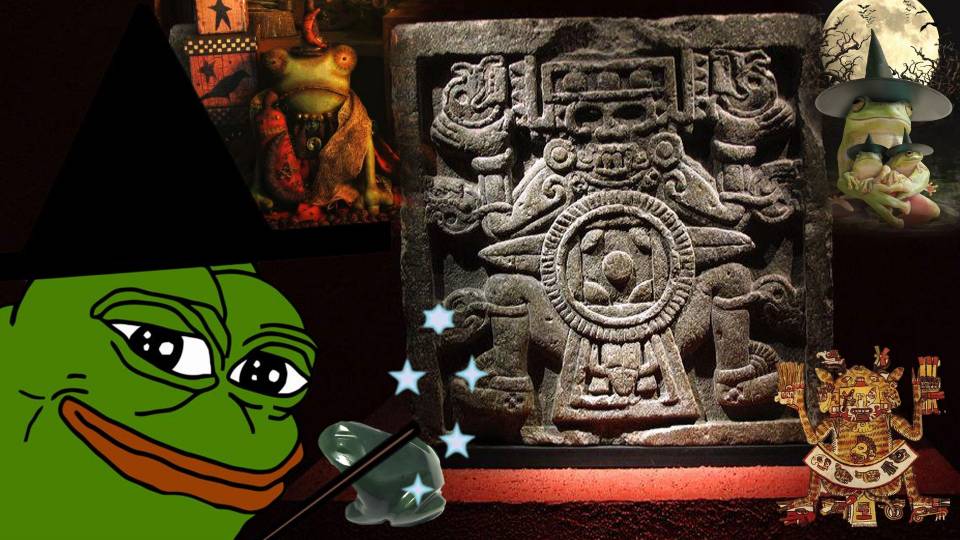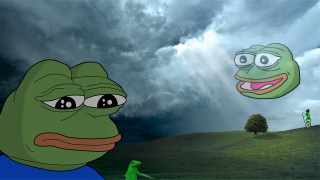Is Pepe the Frog a Witch's Familiar? Deeper Dimensions of the Froggy Meme
With the appearance of Carlos Castaneda's first book in 1969, The Teachings of don Juan, an obscure anthropological term leaked across the sill of the Overton Window and became an acceptable topic of open discussion in growing circles. Going on fifty years from that moment, this term is still not quite a mainstream talking point but it is getting precariously close -- in part due to internet rumors that a certain presidential candidate is using a double. A Mesoamerican word in origin, it has become commonplace in the ever-widening circles of those who take interest in shamanism, entheogenic practices, and explorations of the paranormal and supernatural. It is essential to the shop talk of psychonauts and psychotherapists alike. It informs every discussion of tradecraft among latter-day shamans and experimental mystics. Yet there are still many who do not know how to pronouce it correctly: nagual, nah-WHAL.
The rarely used term nagualism is synonymous with shamanism. Its definition is simply: belief in naguals. For nagual, Wikipedia says: "In Mesoamerican folk religion, a nagual or nahual is a human being who has the power to transform either spiritually or physically into an animal form: most commonly jaguar and puma but also other animals such as a donkeys, birds, or dogs and coyotes." If you hold the "belief in naguals," then you take such phenomena seriously, and you allow that shapeshifting can really occur, even though you might not be able to accomplish it yourself. If you could, you would be a nagual, capable of appearing as yourself, normally, and also in the form of a shamanic double, your "familiar."
Shamanic Folk Lore
Since Castaneda, the main spin on nagual has been Mesoamerican, Peruvian, Amazonian, etc, but the concept is not exclusive to those regions of the planet. Far from it. Long before talk about shamanic doubles became popular, anthropologists and ethnologists had been delving into the phenomenon in European folklore. The witch's familar was massively attested in myth and legend all across Europe, not to mention cultures as far afield as Siberia, China, and Polynesia. The most common and even trite example is the black cat who accompanies a witch, but also is the witch, due to a feat of shamanic doubling. The animal familiar is the double of its human counterpart. As such, it often goes on errands, spies and eavesdrops, or performs magic in the stead of its human counterpart. In countless folk-tales the familiar appears first, announcing that the witch to whom it corresponds is due to show up and work her wiles.
Pepe the Frog clearly represents an emergent social movement, but it may also portend a supernatural agency. In the first aspect, it can be tracked like any other meme or icon of social discourse. It can be considered totally apart from anything supernatural or paranormal -- such is the case so far. Commentators often refer to synchromysticism and memetics (a newly coined term, not to be confused with mimetics) to define the spontaneous signalling from the social/collective subconscious into the exopsyche -- my term for the realm of that which can be named, spoken, discussed. The contents of the social subconscious, which may be called the endopsyche, are in a fugue state of extreme liminality, fluid, ambiguous. Internet memes like Pepe operate like trawling nets that dredge up all kinds of suppressed and transgressive material submerged in the endopsyche. They give definition and direction to the fugue state.
Pepe is obviously a chthonian entity. Chthonos, Greek "earth, ground, primary realm." Chthonian (THO-ni-un) or chthonic (THON-ic), referring to the underworld, the infernal regions. Autochthonous (awe-TOCH-thun-us), "indigenous rather than descended from migrants or colonists"; in geology, "sediment formed in its present position."
This seemingly harmless creature appears in European folk-lore as a common version of the witch's familiar. In a memorable scene in The Virgin Spring (Jungfrukällan, 1960) by Ingmar Bergman (1918 - 2007), a frog magically leaps from a loaf of bread. A cinematic masterpeice, Bergman's black-and-white film made a huge impact due to its strikingly archetypal visual evocations of medieval life. The title offers a vivid glimpse of the "virgin" archetype in close association with sexual magic and witchcraft.
Significantly, the film, set in medieval Sweden, recounts a revenge tale adapted from a 13th century Swedish ballad, recounting a father's brutal response to the rape and murder of his young daughter. The film touches on transgressive issues relating to morality, justice, and revenge. The rape scene was infamous at the time -- compare today, when brutal rape is common fare on Game of Thrones, a cable tv series that presents a brutal evocation of witchcraft in the medieval times. Bergman's classic may well be regarded as prescient in view of the rape crisis in Sweden today. The message of the film resonates over 56 years and brings to mind the question, Who will avenge the rape of Swedish women today?
Revenge and witchcraft are inseparable themes throughout folk lore in Europe and elsewhere. Sometimes the witch's familiar is the instrument of revenge, for instance, assuming the form of a venomous snake or spider. It remains to be seen if the pagan, prechristian ethic of revenge will be adopted by the alt right, pro-white movement in the USA and Europe, but one thing is pretty certain: the chthonic figure of Pepe is here for the long run.
Infernal Origins
So far, investigation of the mythological and ethnological features of the froggy meme has concentrated on remote allusions to Egyptian lore. There is, however, an outstanding case for the Mesoamerican provenance of this nagualist entity.

The Mayan zoomorphs of Quirigua in Guatemala present a jaw-dropping depiction of chthonic powers including jaguar, frog, and reptilian motifs. One commentary says:
"The zoomorphs at Quirigua are like three-dimensional books designed to provide information about the ruler, their power and their conquests. Almost every square inch of these highly decorative monuments is dedicated to imparting information. The largest is Zoomorph P, which weighs in at 20 tons and provides a surface area of 402 metres on which every square-centimetre was ornately engraved. As well as demonstrating the incredible craftsmanship of this often maligned sub-continent, the beastly characters and the glyphs are blended seamlessly together and highlights the meticulous planning that must have taken place before these enormous rocks were even hewn from the ground."
Clearly, Mesoamerican shamans had a deep interest in infernal powers that emerge from the Underworld, or just from underground, who live in swamps and slime, bathing in the primordial chaos, as Pepe the Frog does. As a denizen of those infernal regions, Pepe carries the power to uproot, overturn, and demolish surface structures of the consensus reality. The humble frog is a powerful agent of transgressive forces, fully capable of overthrowing the status quo. But even as such, he is still just a familiar, the double of an even more formidable power.
Recall that the nagual of a supernatural power often appears first, announcing the coming of the principal power. It functions both as omen and emissary. This being so, the question arises, Is Pepe the nagual or familiar of a greater power, a witch? And if so, who is that witch?
Mesoamerican lore identified a primordial earth goddess at the matrix of the animal powers pictured in the Quirigua zoommorph and elsewhere, lavishly, in Maya and Aztec shamanic decor. Her names are various but they may be subsumed in a dominant figure called TLALTECUHTLI: pronounced TLAL-tay-COOT-li.
In his outstanding book on Aztec mythology and culture, The Fifth Sun, Burr Cartwright Brundage (using a variant spelling) describes her in this way:
"The goddess had many aspects, designated by appropriate names. Here we must point out her most material reduction and ultimate presence. She was Tlalteuctli, Earth Lady, the palpable rock and soil and slime upon which men moved and into which they were lowered at death. Tlalteuclti is not a goddess as such, a being anthropomorphically conceived about which myths are told. She was the compendious numen of the earth, even more uncompromising than Tonatiuh was the numen of the sky. In the speculative thought of the Aztecs where was referred to as the mother of all men... Her impact on the Aztec mind was a religious siezure and a terror which had nothing intellectual about it. Unlike the dieties to whom she gave rise and who were always conceived in female shape, she was depicted as a gargantuan toad slavering blood, with clashing jaws at every joint. She represented chaos."
Midwife Toad
Tlaltecuhtli literally means "earth Lord," but most representations depict this entity as female. Her familiar assumes a particular posture: the birth-giving squat, often associated with a frog or toad. The birth-giving motif presents a remarkable elision here with a widely discussed familiar in European folk-lore, the midwife toad. It belongs to a genus of the Alytidae family (formerly Discoglossidae), found in most of Europe and northwestern Africa. European folk lore frequently identifies the midwife toad as the nagual of benevolent witches who assist in childbirth. The squatting position of the toad mimics the actual position on which women usually gave birth previous to modern times, and still do in most parts of the non-urban world.
Curiously, additional to its link to childbirth, the midwife toad has a special association with apoptosis (Greek, "shedding, falling off"), a process of programmed cell death in which an organism sheds part of itself that is no longer viable. In contrast to necrosis, traumatic cell death that results from acute cellular injury, apoptosis is a regulated process that advantages the further mutation of the organism undergoing it. Apoptosis produces cell fragments called apoptotic bodies able to engulf and quickly remove before the contents of the cell can spill out onto surrounding cells and cause damage.
German scientist Karl Vogt first described the principle of apoptosis in 1842, and in 1885, anatomist Walther Flemming produced a more precise description of the process of programmed cell death, based on studies of the developing tadpoles of the midwife toad.
It appears that the supernatural powers of the midwife toad are formidable. The allusions are obvious: Pepe not only carries the power to birth a new culture but also to expel and throw off social structures that are no longer viable, such as the toxic accretions of cultural Marxism, Jewish inspired agendas of multiculturalism and white genocide, and even the entire social justice movement. That is some powerful frog. It looks highly unlikely that Pepe will fade with other topics trending on Google and Twitter. The grinning, green-faced garden pet has a promising future.
Granted that the memetic and archetypal power of Pepe is now widely recognized, and growing exponentially, what about the witch of which he is the familiar? Would it be possible to identify the presence of a chthonic earth goddess comparable to Tlaltecuhtli looming behind the froggy meme? If so, a supernatural presence of infernal feminine power might bring focal unity and coherence to the religious imagination of the altright, pro-white movement -- a factor that has, so far in the definition of the movement, been entirely lacking.
By John Lamb Lash, Oct 2016 Andalucia






















